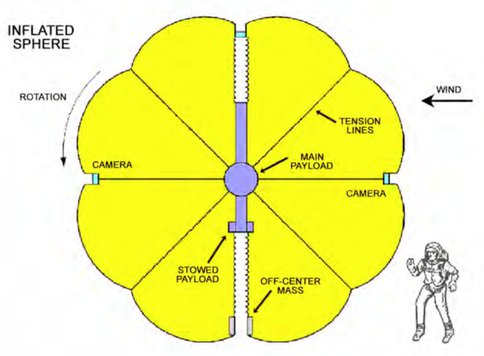2011 Annual Science Report
 University of Wisconsin
Reporting | SEP 2010 – AUG 2011
University of Wisconsin
Reporting | SEP 2010 – AUG 2011
Project 7A: A New Way for Exploring Mars for Environmental History and Biosignatures
Project Summary
Mobile exploration of Mars so far has been achieved by the use of rovers, powered by solar panels or in the near future, radioisotope thermoelectric generators (RTGs). The JPL team has been contributing to an effort to develop an alternative source of locomotion, wind power. A Tumbleweed rover is a large (maybe as big as 20 ft diameter), inflatable structure, equipped with suitable instruments and would be able to make long-range surveys of large areas of Mars. A rover would carry a suite of science instruments for surface and near-surface interrogation and be released to roam for the duration of a season or longer. Although direction will be at the mercy of the wind, location will be tracked precisely and randomized surveys of a large area are equivalent to conventional coordinate grid sampling.
Project Progress
Seasonally receding frost at Mars’ higher latitudes provides liquid water; transient on the surface and longer-lived below it. Sunlight and evaporitic sediment dust offer possible habitats on the surface with sufficient metabolites, although only seasonally. Subsurface habitats might support life for longer. Such surface habitats could cover a very large area, perhaps from 50 degrees to the poles themselves, and thus require a long-range survey for high latitude habitats. Previously, we have shown how his survey could be accomplished with a group of large Tumbleweed rovers, vehicles using the readily available martian wind to traverse the Martian surface with minimal power, performing a variety of measurements over relatively large areas. We already investigated how Tumbleweed rovers could be used to conduct long-range, randomized surveys equivalent to conventional coordinate grid sampling.
The Tumbleweed rover would operate in two modes, for traversing terrain it would be inflated.
Fig. 1 Tumbleweed in mobility mode. The Tumbleweed is fully inflated ready to be moved by the wind (image from Kuhlman et al., 2010).
However, while moving it could still make measurements using surface-mounted contact instruments or shallow penetrating probes. Thus its other mode of operation could be initiated autonomously as result of information from the sensors or at pre-arranged intervals it would halt by partial deflation.
Fig. 2 Tumbleweed in stationary mode. The Tumbleweed is partially deflated to anchor it and to allow operation of analytical instruments (Image from Kuhlman et al., 2010).
Previous work on this concept was aimed at the possibility prospecting for in situ resources, with an instrument suite suitable for that purpose. A particularly valuable resource is water, which is also very much of astrobiological importance. Water can be detected both by ground penetrating radar and by surface-mounted probes. Other things instruments included, multispectral imaging capability, gas sensors and a miniature X-ray fluorescence elemental analysis device.
We have continued to try to develop a realistic science investigation approach and associated instrument suite concept for surface and near-surface investigation of both habitability and the presence of biosignatures. For water and temperature measurement, the TECP (Thermal and Electrical Conductivity Probe), built by Decagon Devices, Inc. for the highly successful NASA Phoenix Lander, is a very competent miniature instrument, which can monitor six parameters (dielectric permittivity, electrical conductivity, temperature, thermal conductivity, volumetric heat capacity, and relative humidity). Most importantly, it can make a measurement in 10 milliseconds and thus could be used while in transit. The other essential for a baseline instrument package would be not only for detection of gases but also analysis of their stable isotope compositions. Rather than use conventional mass-spectrometry, it would be better to use a tunable laser isotope spectrometer to measure to ppm levels of soil gases as well as atmosphere, like TLS, deployed as part of the SAM instrument on MSL. This would be done with the Tumbleweed stationary and would include, ammonia, methane, hydrogen sulfide and sulfur dioxide as well as water. However, development of the appropriate IR laser absorption systems for ammonia and hydrogen sulfide have not been developed yet. The instrument suite should be easily reconfigurable using common data and communication systems. In addition to the baseline package other instruments could be of value for wide-ranging surveys, for example, the APXS elemental analysis instrument flown on many Mars missions, a green Raman spectrometer for mineral identification, a UV Raman for organic matter analysis and the life marker chip, selected for the ESA/NASA Exomars mission.
Although this type of rover is still at the concept stage for Mars exploration, a field trial of a smaller (approximately 6 ft diameter), inflatable Tumbleweed was made in the Antarctic as long ago as 2004.

Fig. 3 An inflatable tumbleweed deployed in the Antarctic, 2004. (Image credit: J. Dana Hrubes / National Science Foundation).
This approach to mobility on Mars, authors many potential advantages including lower mass of the vehicle and therefore a larger relative proportion of instrument mass, which equates to a more comprehensive instrument suite.
Publications
- Kuhlman, K.R., Behar, A., Jones, J., Boston, P., Jeffrey Antol, J., Hajos, G., Kelliher, W., Coleman, M., Crawford, R., Rothschild, L., Buehler, M., Bearman, G., Wilson, D.W. & McKay, C.P. (2010). Tumbleweed: a new paradigm for surveying Mars for in-situ resources. In: Badescu, V. (Eds.). Mars, Prospective Energy and Material Resources. Springer-Verlag Berlin Heidelberg.
- Kuhlman, K.R., Behar, A., Jones, J., Boston, P., Jeffrey Antol, J., Hajos, G., Kelliher, W., Coleman, M., Crawford, R., Rothschild, L., Buehler, M., Bearman, G., Wilson, D.W. & McKay, C.P. (2010). Tumbleweed: a new paradigm for surveying mars for in-situ resources. The Aerospace Division of the American Society of Civil Engineers, Earth & Space 2010 Conference papers of Earth and Space.
-
PROJECT INVESTIGATORS:
-
RELATED OBJECTIVES:
Objective 2.1
Mars exploration.
Objective 7.1
Biosignatures to be sought in Solar System materials


